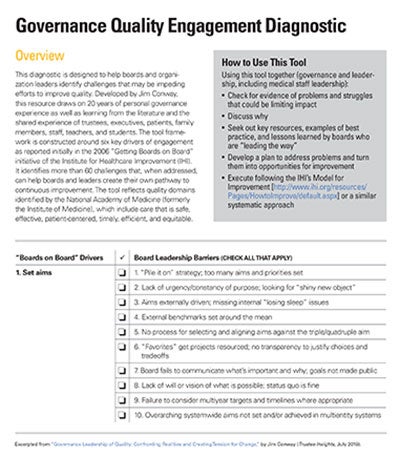
Quality & Patient Safety
Governance Leadership of Quality: Confronting Realities and Creating Tension for Change
A self-assessment tool can help health care boards address barriers to effective quality oversight
By Jim Conway
Governance
Leadership of quality is a key responsibility of governance and, done well, serves as an exceptional gift: engaged boards produce better outcomes. For all the progress made over the last 20 years, however, many boards, trustees, and executives continue to struggle with quality oversight.
Trustee Talking Points
- The evidence grows that engaged boards produce better quality outcomes.
- Yet many boards and executives struggle with quality and safety oversight.
- Outmoded board structures, processes, and outcomes can impede achievement.
- Tools, frameworks, and guides are available to foster continuous improvement.
The board, board chair, and CEO, together, must ensure that their vision, strategy, and goals are strong and aligned. Further, they must confront the realities of current practices, specifically those that are impeding achievement. Use of a "Governance Quality Engagement Diagnostic" (a tool introduced below), along with a careful approach to organization assessment, can identify barriers to effective board quality oversight and help drive understanding, learning, and continuous improvement.
Issues and Implications
Over the last 20 years, the health care field has been on a quality journey, including a strong and constantly renewing focus on the engagement of governance to achieve quality outcomes and care that is safe, effective, patient-centered, timely, efficient, and equitable. Bold aims have been set at national, system, and entity levels. Extensive contributions to improve practice have come from individuals, health care organizations, regulatory and accrediting organizations, research, literature, and continuing education.
Much has been achieved via this broad emphasis and engagement across the field. Self-assessment tools, frameworks, and guides are available so that organizations can assess how they measure up against best practices. The evidence grows that engaged boards produce better outcomes.
In 2017, the Joint Commission issued Sentinel Event Alert #57, affirming the essential role of leadership, and specifically governance, in developing a safety culture. Yet struggles, problems, and challenges with board engagement exist at many hospitals and health systems and, for some, they grow.
Many trustees and executives remain frustrated with outmoded board structures, processes, and outcomes. It is not unusual to walk into a boardroom and find trustees and leaders dealing with many of the same barriers they struggled with five, 10, or 20 years ago. For all we have accomplished to improve quality – and we have done a lot – there is much more to do for those we partner with and serve: patients, families, the public, health care organization staff, and communities.
In his book The Fifth Discipline (1990), Peter Senge introduced the powerful concept of “creative tension.” He noted that leadership in a learning organization begins with creative tension, which comes from clearly seeing where we want to be (our vision), and telling the truth about where we are (our current reality). The gap between the two generates a natural tension. Creative tension can be resolved in two basic ways: by raising current reality toward the vision, or by lowering the vision toward current reality.
Individuals, groups, and organizations who learn how to work with creative tension understand how to use the energy it generates to move their realities more reliably toward their visions. Similarly, Carl Weick and Kathleen Sutcliffe, in their 2001 book Managing the Unexpected, encouraged developing a preoccupation with failure, now the first principle for High Reliability Organizations (HROs). This principle stresses the need for continuous attention to anomalies that could be symptoms of larger problems in a system. When people look for failures, they acknowledge the existence of incomplete knowledge.
Over the last 20 years, as an executive, improvement adviser, trustee, graduate school teacher, and patient and family member, I have come to believe that we must utilize more effectively the power of creative tension and a preoccupation with failure as we assess and confront more directly the struggles and problems many boards and leaders face in optimizing their processes and achieving better outcomes. The first step in the journey to higher quality is to understand the current reality and the challenges it presents.
TRUSTEEToolbox

A diagnostic tool designed to help boards and organization leaders identify challenges that may be impeding efforts to improve quality.
A Diagnostic Tool
The Governance Quality Engagement Diagnostic is a self-assessment tool that can help health care boards and leaders highlight barriers and challenges to effective board engagement in quality oversight. The tool framework is constructed around six key drivers of engagement as reported initially in the 2006 "Getting Boards on Board" initiative of the Institute for Healthcare Improvement (IHI): set aims; get data and hear stories; establish and monitor system-level metrics; change the environment, policies, and culture; learn from others and from each other; and establish executive accountability.
Organized within these key drivers are more than 60 challenges identified over the last 20 years from my own teaching engagements, consultations, site visits, and personal experiences as a trustee, as well as those reported by colleagues and in the literature. The tool was vetted with, and revised after, input from leaders with expertise in governance and quality. Testing the diagnostic in conference and classroom settings with trustees and health care executives indicated that people found considerable resonance with the tool’s content, which, in turn, triggered significant discussions.
Challenges and Opportunities
Effective use of this tool is highly dependent on the board’s culture. Before employing this diagnostic, boards should answer questions such as:
- Is this organization a safe place to speak up?
- Do people believe assessment findings will be used to drive change and improvement?
- Is it worth our taking the risk?
- Do we use a systematic model for improvement?
Trustee Takeaways
- Leadership of quality is a key responsibility of governance in health care.
- The board and CEO must work together to align vision, strategy, and goals.
- They must also reexamine practices to identify barriers to effective oversight.
- A Governance Quality Engagement Diagnostic can be an effective learning tool.
Using the tool can provide an opportunity to enhance the board’s culture. For trustees and leaders frustrated over board practices, identifying and fixing barriers and challenges will help them participate in driving engagement forward: it is what matters to them. They are personally invested in positioning the board and organization for success.
Using the Diagnostic Tool
Employing IHI’s Model for Improvement or a similar systematic approach, trustees and executives must commit to use the results and learning from the tool to drive change and improvement. Results must be compiled and presented to the board, as well as discussed and prioritized. Action plans then can be developed to drive improvement. During the process, organizations can seek out key resources, examples of best practices, and lessons learned by boards and associations leading the way to better outcomes. Many boards are already turning obstacles identified through the assessment into significant opportunities for continuous improvement.
